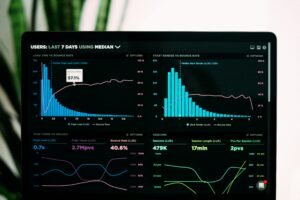How do we calculate social media ROI – Calculating social media ROI (return on investment) can feel as elusive as finding a unicorn in Central Park. But understanding social media ROI isn’t just a guessing game; it’s crucial for showing the big wigs—your stakeholders—that your strategy’s worth every dime. In this post, we’ll break down the secrets to measuring ROI, the important metrics to focus on, and the tools that will make the process a breeze. Ready to turn your social media efforts into quantifiable success? Let’s go!
How do We Calculate Social Media ROI
Social media ROI is like a report card for your digital marketing. It measures the value you gain from investing in social media using dollars or other metrics. This is crucial as it shows how effective your strategies are. It’s especially vital for persuading bosses or investors about marketing plans.
Knowing your social media ROI helps in deciding where to invest money and time. If a strategy isn’t working, you can change it. If it’s effective, you’ll know to invest more. Essentially, it ensures smarter spending—a must when budgets are tight.
Important Metrics for Social Media ROI
Here are five common metrics for calculating social media ROI:
- Engagement Rates: The number of people interacting with your content.
- Reach: The count of unique users who view your content.
- Conversions: Actions like signing up for a newsletter or purchasing a product.
- Cost-Per-Click (CPC): What you pay when someone clicks on your ad.
- Click-Through Rate (CTR): The percentage of viewers clicking on your content.
Key Metrics for Measuring Social Media ROI

Let’s dig into the important metrics that reveal the effectiveness of our social media efforts. First are engagement metrics—such as likes, comments, and shares. These are like high-fives from the internet. Higher engagement boosts visibility, potentially leading to more clicks and conversions. So, a successful post can enhance your ROI.
Next is Earned Media Value (EMV). This metric puts a dollar value on the exposure you get from influencers sharing your brand. It compares this exposure to what you’d spend on ads for similar reach. Knowing your EMV helps allocate your budget effectively.
Audience quality and top-performing posts also impact ROI. Audience quality means reaching people who are likely to buy, not just browse. Top-performing posts show what resonates best. By focusing on these metrics, you can adjust your content strategy for improved ROI.
Here are four key metrics for measuring social media ROI:
- Engagement Metrics: Likes, comments, and shares boosting visibility.
- Earned Media Value (EMV): Free exposure’s monetary value from influencers.
- Audience Quality: Reaching potential buyers over casual browsers.
- Top-Performing Posts: Successful content for replication and better results.
Use these metrics to steer your way to social media success!
How do We Calculate Social Media ROI: Formulas and Tools
Want to know if your social media campaigns are worth it? Here’s how:
The basic ROI formula is:
ROI = (Revenue – Costs) / Costs * 100%
This formula shows the percentage return on investments. When applied to social media, it asks if your spending on ads and content brings in more revenue. For example, spending $500 on ads that earn $1,000 results in a 100% ROI. Not bad, right?
Analytics tools simplify these calculations. They help gather and analyze data, making ROI estimates precise. Imagine manually tracking clicks and shares—no thanks! Tools like Hootsuite, Sprout Social, and Google Analytics do this efficiently, providing insights for strategy tweaks to maximize ROI.
Top tools for boosting your social media ROI analysis:
- Hootsuite: Comprehensive analytics for tracking performance and optimizing content.
- Sprout Social: Detailed reports to understand audience engagement and ROI.
- Google Analytics: Tracks traffic and conversions from social media channels.
Enhancing Social Media ROI: Strategies and Optimization

Testing and optimizing content is key to boosting engagement and ROI by experimenting with different content types like videos and infographics to see what resonates with your audience. Analyzing competitor strategies and using UTM parameters for tracking can further enhance your efforts, revealing effective strategies and helping you refine your approach for maximum returns.
1. Content Testing and Optimization
Boost ROI by testing different content types. Discover if your audience prefers videos over lengthy posts. Use A/B testing to change one element at a time, like a headline or image. Let engagement metrics guide you. The aim is to find content that not only resonates but also converts.
2. Leveraging Competitor Insights
Treat competitors as mentors. Study their successful campaigns to uncover effective strategies. Analyze their top posts, engagement patterns, and content types. Use insights to refine your approach. Remember, it’s about adapting, not copying, while fitting your brand’s distinctive voice and goals.
How do We Calculate Social Media ROI – Reporting and Analyzing
Effective reporting demonstrates the value of social media efforts. It’s like showing a movie of successes and activities to stakeholders, keeping them informed about what’s working. Reports justify resources allocated to social media marketing and ensure everyone knows the direction of efforts.
Make reporting easier with dashboards and data analysis tools. They collect data and present it in clear formats. These tools highlight trends and pinpoint areas needing improvement—essential for strategy adjustments to boost ROI. Insights from dashboards reveal standout campaigns and those needing enhancements.
Essential elements of a social media ROI report:
- Engagement Metrics: Likes, comments, shares, and interactions.
- Traffic Sources: Identify audience origins.
- Conversion Rates: Actions resulting from efforts, like sales.
- Cost Analysis: Compare spent money to gained value.
Conclusion
Nailing the art of calculating social media ROI means two things: knowing your goals and picking the right metrics. We’ve walked through why ROI matters, like showing off your strategy’s value and making smart budget choices. We’ve explored what to measure—likes, shares, EMV, and more—and the tools to make it simple.
Remember that social media success isn’t just luck. It takes testing, learning, and tweaking your approach. So, get in there, crunch those numbers, and watch your efforts pay off! With some practice, answering “How do we calculate social media ROI” will be a breeze.
FAQ
How do we calculate social media ROI and its significance?
Social media ROI measures the value of social media investments. It’s crucial for showing how effective your digital marketing strategies are and helps justify budget and resources.
How do you calculate social media ROI?
The formula for calculating ROI is:
[ \text{ROI} = \frac{\text{Revenue} – \text{Costs}}{\text{Costs}} \times 100% ]
This helps evaluate if your social media efforts are financially effective.
What is the difference between organic and paid social media marketing?
Organic marketing is unpaid and focuses on engagement through regular posts. Paid marketing involves ads that reach wider audiences quickly, impacting ROI differently.




